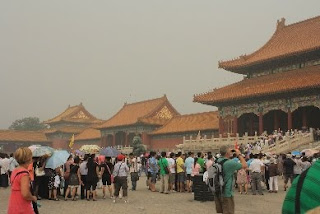The rest of city is built on the same orientation and grid pattern, with concentric rings moving outward around the city making it easy to navigate ( just not on foot because of scale ). Interestingly, I am finding many contradicting forces in this continuously evolving country, seemingly in spite of these ideas of balance . A visit to Tia'namen Square for example, and one is greeted with a enormous public space in obvious reverence to Mao Ze Dong . People line up for a quarter mile to pay tribute to his "tomb," merely a modern version of the dynasty tombs he worked to destroy in the name of communist ideals. Yet at the same time, you see men walking around in Business suits and peasants begging for change.
Just north of Tia'namen Square is the Forbidden city,as mentioned, perfectly centered in the universe ( at least in theory). Some other ancient and traditional sites that I visited were the Summer Palace and Temple of Heaven, both of which have traditional Chinese gardens. And a trip to China would not be complete without seeing the great wall. A 4,000 km long construction project that spanned dynasty's.
The hutongs, depending on who you ask, can either be jewels or slums. Essentially, the only remaining "old town" other than the palaces and tourist attractions, the hutongs are very much alive. The small scale pedestrian neighborhoods give you chance to envision life before the high rise in Beijing, Courtyard houses share toilets, doors painted red (usually left open) and pockets of gardens give a modest idea of what life in china might be like for the average person.
Some modern examples can be found in Beijing through the CCTV headquarters by OMA , and a projects dubbed "Linked Hybrid" by New York Based Steven Holl architects. Both of which are large scale examples of new urban forms. Both examples start to cleverly mix vertical solid form with horizontal solid forms to provide a more provocative public domain. though they both serve different program, I feel both project's are a hint at a more functional move ment away from the monolithic high rise.
In many way I see no aspects of communism in China. Classicism is extremely prevalent. I do however feel that I can see China changing before my eyes. Beyond just the construction, I see the pressure of the younger citizens for continued reform, and a some times volatile transitions to a market based economy. From what I have found, the government is starting to pay for less and less things, the price of living is becoming more expensive, and the income gap is becoming greater. I feel like they want so bad to be held to the same standards as "Western Nations" (and they should be) yet at the same time are very apprehensive about swaying from their communist heritage.





No comments:
Post a Comment